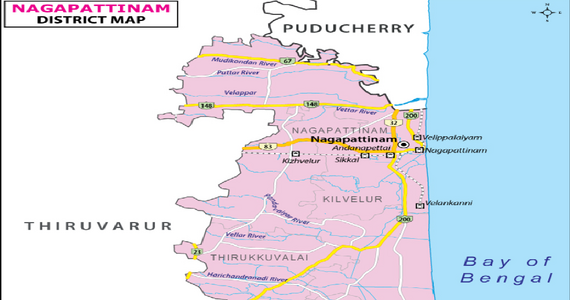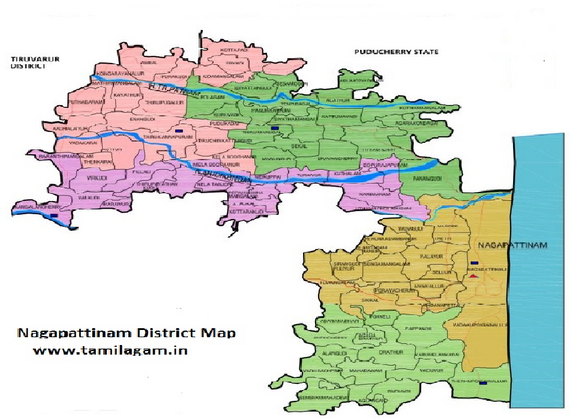
Here is a comprehensive tourist map guide for Nagapattinam — including everything you’ll need (places, how to reach them, best route, approximate times) so you don’t have to look anything else up.
1. Overview
Nagapattinam is a coastal district located in the southeastern part of Tamil Nadu, along the Bay of Bengal. The district is famous for its religious diversity, ancient temples, Christian pilgrim centers, scenic beaches, and bird sanctuaries. It combines spiritual charm with serene coastal beauty, making it ideal for both cultural and nature-oriented tourism.
2. How to Reach Nagapattinam
By Air:
The nearest airport is Tiruchirappalli International Airport (around 145 km away). From there, you can take a bus, taxi, or train to Nagapattinam.
By Rail:
Nagapattinam Railway Station is well-connected with major cities such as Chennai, Tiruchirappalli, Thanjavur, and Velankanni.
By Road:
Regular state and private buses operate from Chennai, Thanjavur, Tiruchirappalli, and other cities to Nagapattinam. The town is connected by National Highway 45A and several state highways.
By Sea:
There is no regular passenger sea route, though the port of Nagapattinam handles minor cargo and fishing activity.
3. Best Time to Visit
- Winter (November to February): The most pleasant season, ideal for sightseeing and beach activities.
- Summer (March to June): Hot and humid, suitable for short temple visits.
- Monsoon (July to October): Frequent rainfall; lush surroundings but some outdoor spots may be less accessible.
4. Major Tourist Attractions
4.1. Velankanni – Our Lady of Good Health Basilica
One of the most important Christian pilgrimage centers in India. The Basilica of Our Lady of Good Health attracts millions of devotees every year. The white Gothic church near the beach is famous for its annual festival in August–September. The surrounding area also offers a pleasant beach experience.
4.2. Kayarohanaswamy Temple, Nagapattinam
An ancient temple dedicated to Lord Shiva, known for its Chola-period architecture and the legend of Lord Shiva’s manifestation as Kayarohana. The temple also houses a shrine to Goddess Neelayadakshi. It is located in the heart of Nagapattinam town.
4.3. Soundararaja Perumal Temple
A revered Vaishnavite temple dedicated to Lord Vishnu, considered one of the 108 Divya Desams. It showcases classic Dravidian architecture and intricate sculptures.
4.4. Dutch Fort and Archaeological Museum
Built in 1620 by the Dutch East India Company, this fort reflects the colonial history of the region. Parts of it have been restored and house historical exhibits and archaeological findings.
4.5. Point Calimere (Kodikkarai) Wildlife and Bird Sanctuary
A natural sanctuary located about 55 km from Nagapattinam. It is a protected area for migratory birds such as flamingos and herons, and is home to blackbucks and wild horses. The coastal stretch offers a peaceful beach and mangrove ecosystem.
4.6. Nagapattinam Beach
Located close to the town center, this beach provides a calm environment for evening walks and sunrise views. It is less crowded than Velankanni and known for its fishing harbor nearby.
4.7. Vedaranyam
A historically significant town linked with the Salt Satyagraha movement during India’s freedom struggle. The Vedaranyeswarar Temple here is also an important pilgrimage site.
4.8. Sikkal Singaravelan Temple
Situated about 5 km from Nagapattinam, this temple is dedicated to Lord Murugan (Subramanya). It is famous for the ritual of transferring the Vel (divine spear) to Lord Murugan before the Soorasamharam festival at Tiruchendur.
4.9. Poompuhar (Kaveripoompattinam)
An ancient port city located around 40 km from Nagapattinam. It was once part of the Chola kingdom and is famous for archaeological remains, a beach, and the Government Art Gallery depicting episodes from the Tamil epic Silappathikaram.
5. Suggested Itinerary
Day 1
- Morning: Arrive in Nagapattinam, check into hotel.
- Late Morning: Visit Kayarohanaswamy Temple and Soundararaja Perumal Temple.
- Afternoon: Explore Dutch Fort and Archaeological Museum.
- Evening: Relax at Nagapattinam Beach.
Day 2
- Early Morning: Drive to Point Calimere Wildlife Sanctuary for bird watching.
- Afternoon: Visit Velankanni Basilica.
- Evening: Shopping and dinner near Velankanni Beach; stay overnight or return to Nagapattinam town.
6. Local Transport and Connectivity
- Auto-rickshaws: Readily available within town limits.
- Taxis and cabs: Best for visiting distant spots like Kodikkarai or Vedaranyam.
- Local buses: Operate between Nagapattinam, Velankanni, and nearby towns.
- Bicycle rentals: Available in some beach areas for short rides.
7. Accommodation Options
- Budget: Tamil Nadu Tourism Hotel, local lodges in Nagapattinam town.
- Mid-range: Seagate Hotel, Hotel VPN Residency, Golden Sand Hotel in Velankanni.
- Luxury: MGM Velankanni Residency and private beach resorts.
Tip: During the Velankanni festival season (August–September), book accommodation well in advance as hotels fill up quickly.
8. Food and Dining
- Local cuisine: Primarily South Indian – idli, dosa, vada, sambar, and seafood dishes.
- Specialties: Crab curry, prawn fry, and coconut-based gravies.
- Vegetarian options: Widely available, especially around temples.
- Beachside stalls: Serve fresh fish and local snacks; ensure hygiene before eating.
9. Shopping and Handicrafts
- Traditional silk sarees and handloom textiles.
- Shell crafts, conch products, and wooden carvings near Velankanni Beach.
- Small-scale handicrafts and temple souvenirs from Nagapattinam markets.

10. Practical Tips for Tourists
- Weather: Carry light cotton clothes, sunscreen, and a hat for protection against heat.
- Footwear: Comfortable sandals or walking shoes recommended.
- Temples: Remove footwear before entering; dress modestly.
- Photography: Some religious sites may restrict photography; ask permission before taking pictures.
- Health: Drink bottled water; avoid raw street food during summer.
- Transport safety: If traveling by auto or taxi, negotiate fare beforehand or use prepaid counters.
- Waste management: Dispose of waste responsibly; beaches and temples must be kept clean.
- Emergency contacts:
- Police: 100
- Ambulance: 108
- Fire: 101
- Nearest Hospital: Government District Hospital, Nagapattinam
11. Local Festivals and Events
- Velankanni Annual Feast: August–September, attracts millions of pilgrims.
- Chithirai Festival: Celebrated at Kayarohanaswamy Temple during April–May.
- Masi Magam: Held in February or March when temple deities are taken to the sea for rituals.
- Navaratri and Deepavali: Widely celebrated across temples in the district.
12. Emergency and Tourist Support
- Tourist Office: District Tourism Office, Collectorate Complex, Nagapattinam – 611001.
- Tourist Helpline: 1800-425-31111 (Tamil Nadu Tourism Helpline).
- Website (for updates): Nagapattinam District Administration and Tamil Nadu Tourism Department.
13. Summary Map Information
Nagapattinam district lies between Thanjavur to the west, Karaikal (Puducherry Union Territory) to the north, and the Bay of Bengal to the east.
Key travel distances (approximate):
- Nagapattinam to Velankanni – 12 km
- Nagapattinam to Point Calimere – 55 km
- Nagapattinam to Vedaranyam – 45 km
- Nagapattinam to Poompuhar – 40 km
14. Final Travel Tips
- Plan at least two full days to experience both spiritual and natural attractions.
- Early mornings and late evenings are the best times for sightseeing due to moderate weather.
- Keep cash handy as card facilities may be limited in smaller towns.
- Be respectful of local customs and dress codes.
- Avoid night travel in rural coastal areas.
- Always confirm transportation schedules, especially if relying on local buses.